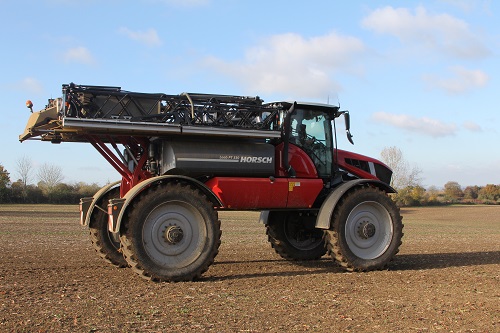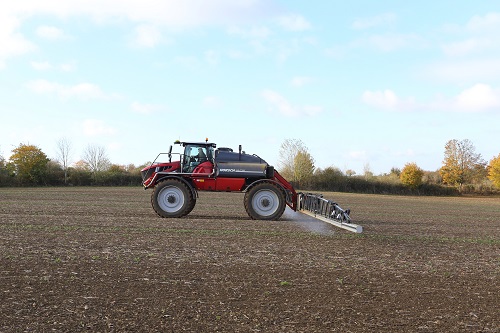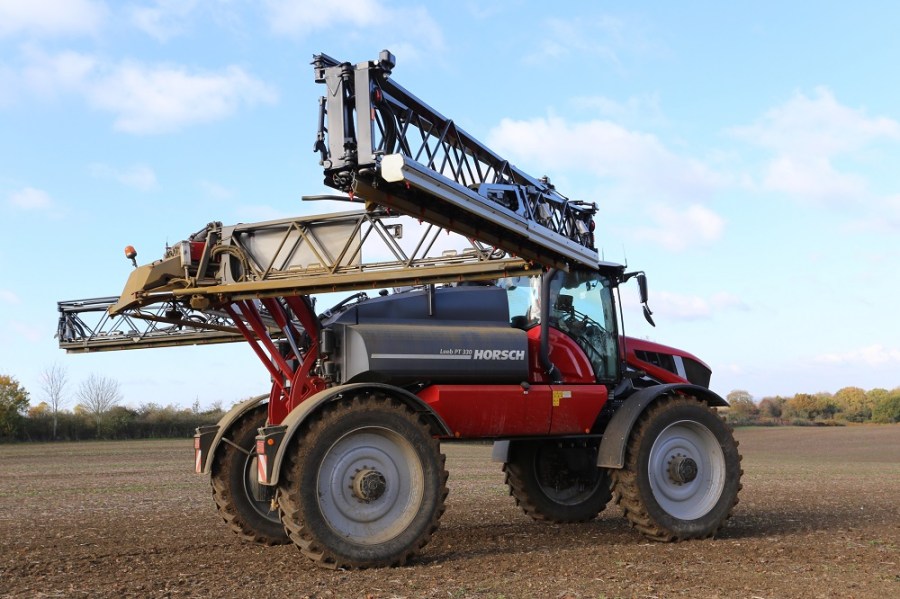Its size was a shock, but the first Horsch Leeb PT330 sprayer to arrive in the UK has proved its worth on the Courteenhall Estate in Northants. CPM visited to see the beast in action.
The Horsch is a real game changer and it’ll probably take us a while to get our heads around what it really means to the farming business.
By Jane Brooks
A system of controlled traffic farming and a block-cropping strategy organised around blackgrass control were the main drivers in the decision to invest in a Horsch Leeb PT330 sprayer on the Courteenhall Estate in Northants. After its first few hundred hours in the field, farm manager Charlie Reynolds admits he’s pretty impressed.
In the few months that Charlie Reynolds has been at Courteenhall Estates he’s faced the perennial problem of blackgrass. “I actually arrived to work at Courteenhall at around the same time as the sprayer,” he explains.

With an operating speed of up to 30km/h in the field and a road speed of 60km/h, independent wheel suspension and all wheel steering give it good manoeuvrability on and off the field.
“We work on a 12m controlled traffic system here. We’re min-tilling most crops, going once or twice over with a 12m Horsch Joker and then drilling with the 12m Horsch drill. Oilseed rape is drilled straight into the stubble with some narrow coulters.”
The Courteenhall Estate has been in the Wake family since 1672 and is very much a family business. It encompasses weddings and events, commercial and rental property, filming and photoshoot locations as well as the farming operations. Managing partner Johnny Wake explains why they went for the Horsch sprayer.
“Financially, we’d already made the decision to upgrade, because the Bateman we were using was past it, so doing nothing didn’t really seem an option. We looked at keeping it, but it wasn’t going to be viable for more than a year or two.
“We also wanted a 36m boom on a machine that had the capacity to fit our track width system, so then it was a question of going for the Horsch or possibly a RoGater which was the other option that we considered. We’ve invested a lot of money on our grid control traffic system and we needed to make sure any new piece of technology would fit into the system.

Horsch’s patented boom technology separates the boom from the machine so it works independently from how the machine is travelling across the field.
“Then another thing is the Horsch boom technology – it’s very difficult to put a value on that. It gives you so much more accuracy when you’re spraying and it’s engineered to an incredible degree. In fact, it’s just an amazing machine, even its self-cleaning mechanism is extremely effective, so it seemed like a good way to future proof our farming system, but the size of it was a shock to us. The Horsch is a real game changer, however, and it’ll probably take us a while to get our heads around what it really means to the farming business.”
Featuring an on-the-move adjustable track width of up to 3m and Horsch’s patented Boom Control Pro system, which keeps the boom stable even when it’s just working at a height of 30cm, it’s capable of spraying speeds of up to 30km/h. The sprayer’s fitted with a 326hp MTU Mercedes OM 926 LA common rail six-cylinder water-cooled, turbo charged engine, which reaches Tier 3 emission standards and doesn’t use Adblue. As the first production model to arrive in the UK, it was vital to have good manufacturer backup and Charlie Reynolds has high praise for the aftercare Horsch has given them.
“Lawrence at Horsch is always on the end of the phone if we need him, and they’re are learning about the sprayers as well as ourselves so we’re in close contact with them. So far we’ve done over 200 hours on it and mechanically it’s been great but there have been one or two small software issues and we’ve an upgrade coming in this week.
“There was quite a lot to learn about the machine. Horsch came out to us for a day and just taught us how to spray with it and then they came out 10 days later to familiarise us more with all its capabilities, the Topcon system and interior controls.”
The estate uses John Deere Greenstar auto-guidance as the field tracking system, so in addition to the Horsch control screen there’s also a John Deere Greenstar screen in the sprayer’s cab. It’s quite a climb up into the cab, and Charlie Reynolds points out that he’s over 6ft tall but still shorter than the wheels.
“The cab is well proportioned, extremely well insulated and equipped with Climatronic air conditioning. It has a full set of carbon filters, so anything that comes in should be neutralised,” he adds.
“When it comes to manoeuvrability we’ve got one or two adjustments to make on the estate around trees and gaps just to move it around. The physical size of it on the road can be intimidating to other traffic as it’s bigger than a combine and you can look down into a lorry when you’re driving it. It has a top road speed of 60km/h and I find it’s remarkably stable on the road. There are two driving modes – one is on the main control joystick while the other is on the same system but using a foot throttle. Personally, I prefer using the joystick on the road just because I feel a bit more in control.
“Regarding operational efficiency, the Bateman was considerably smaller, so it’s a bit of a learning curve relating to logistics, but I think the secret to the machine will be keeping liquid near to it rather than having to return to the yard, so we’ll be taking bowsers out. We have two bowsers of about 15,000 litres each and are currently working out a route around the estate. We’ll put a bowser into each block as it needs spraying so that while one is being filled, the other one can be out.
“It’s capable of spraying at 30km/h and I’ve tried it at almost that speed, but the auto-steering system is unable to keep up and turns itself off. We’re not running it on the full CFT system yet so there’s no field guidance, but on the field it drives well and is fairly stable.
“There’s a calculator by the filling bowl so we can dial in exactly how much water we want and how many litres per ha we’re doing – the pressurised pump fills it and automatically stops when you have the required amount of water on board. There’s also an auxiliary 500-litre clean-water tank that you just fill with a hosepipe, for washing out in the field or it can be used by the on-board pressure washer.
“An additional three-inch filling system is fitted as we’re going to do all the fertiliser with the sprayer, so from a bowser we can pump directly in the top of the tank without having to go through the on-board filling system. There’s a filler point at the front of the steps so you can drive up to the bowser, put 5000 litres in and off you go again.
“We use straight liquid fertiliser, mainly UAN (urea-ammonium nitrate) with some sulphur in as well. There’s an aluminium boom so we shouldn’t have any trouble with corrosion, although with the electric quad bodies we just need to be a bit careful.
“Our agronomist Jon Yeoman is quite impressed with the machine – we plan to get some water-sensitive paper out to check some applications with it. But we’re running on about 220-250 micron droplet size, which is exactly where we want to be, and we’re going to be so much more accurate in the application of the materials we’re putting in.
“Also nozzle technology is impressive – we have 25cm spacings and this, in combination with boom control, allows a boom working height of 30cm which gives a large reduction in drift. So when we’re doing herbicide applications, we can effectively target the nozzles. With a combination of a backwards and forwards nozzle on the main bodies and a vertical nozzle it gives us three chances of hitting our target particularly on blackgrass,” notes Charlie Reynolds.
With autumn drilling finished, the sprayer has also completed the season’s pre-emergence spraying. “Our rotation is planned using varieties with different maturity rates across the blocks that we farm – the OSR we’re growing on the home farm is an early maturing variety with one that comes to harvest later. On the contract-farming area we’re growing a medium-maturing variety, so we don’t have the problem of them all being ready to harvest on the same day. Similarly with the wheat, we’re growing Skyfall, an earlier variety of milling wheat, through to KWS Santiago which matures later.
“This year, we hit the quality on the Skyfall, but it didn’t match last year’s yields. The OSR yielded slightly lower than expected, but when we looked at the irradiance data in May and particularly in June when ear fill is happening, we only had about 60% of the strength of daylight.
“One way we track sunlight is through the roof-top PV panels on some of the farm buildings, using their quarterly generation figures, while our agronomist also provides records through Frontier.
“However, as we got through to the later-maturing varieties and spring beans, July was brighter so they were still taking on some yield and towards the end of the harvest we were up to around 10.5t/ha on the wheat, although the Skyfall was lower than we were budgeting for.”
With a number of anaerobic digester plants in the area Charlie Reynolds is looking to expand into contract spraying. “With the amount of feedstock maize in the ground that’ll need spraying later in the year, this machine would be ideal with its 1.6 metre ground clearance and adjustable track widths.”
One thing that did prove a problem was finding somewhere to park the sprayer up as only one barn on the farm is high enough and finally Charlie Reynolds said, “We did run it over the weighbridge empty to see what it weighed, it’s 14.5 tonnes and every bit of it has a purpose.”
Estate move to CTF
The Courteenhall Estate has been in the Wake family for several generations and within the farming business they’ve adopted a controlled traffic system over the past three years. The estate’s own Real Time Kinetic (RTK) base station is sited at the home farm, and currently operates over a 12-mile radius, although there’s room for expansion. This brings in the repeatability and greater GPS-steering accuracy, at +/- 2cm.
This has allowed the establishment of permanent tramlines, which has reduced the total trafficked area on the farm by controlling where tractors and machinery run, lowering operating costs and leading to less soil compaction. GPS mapping of fields, carried out by Soyl, has given agronomist Jon Yeoman of Frontier the tools to use precision data when making seed-rate calculations and determining fertiliser application rates.
The Courteenhall system uses 12m passes, with the sprayer operating at 36m passes using the same tramlines. The tramline width is 3m, to match the Claas combine tracks, so the ability to put the wheel track of the sprayer out to match has been an important requirement for the estate. This also helps stability when spraying.
With farm traffic all working on a common track width and spacing, movements are kept to a minimum. Using this configuration, wheeled movement should be 15% or lower of field area.
Keeping booms in check
Horsch’s patented BoomControl Pro was one of the deciding factors in the decision to purchase the Horsch Leeb PT330 for use on the Courteenhall Estate. Developed in-house by Horsch, two fast-acting air rams work in opposition to deliver very smooth boom movement. Gyros and boom-mounted sensors feed data back to a proportional control system that counteracts virtually all yaw and roll, according to Horsch.
A separately patented boom suspension uses a hydraulically spring-loaded and damped parallelogram designed to keep the boom close to the axle to provide a stable boom platform. Here the boom is hydraulically separated from the machine, allowing the boom-arm sensors to adjust heights completely independently from each other and also from how the machine itself is travelling across the field.
The boom sensors will pick up the boom to lift it over an obstruction, such a post, or as was demonstrated by Charlie Reynolds, the boom lifts when a hand is placed under a sensor, returning it to the programmed height as soon as the hand is removed.
It can be set to spray as low as 300mm and the boom sensors will adjust its height dependent on the field contour or if there’s an obstruction, so it stays close to the target area even if it’s operating on hilly terrain. BoomControl Pro won both Best New Product or Innovation and Best New Product of Innovation (Mechanical – Crop Production Equipment) category at LAMMA in 2015.
Another feature that appeals to Charlie Reynolds is the pneumatic individual nozzle control on the boom. This allows the spraying line to be fitted with a large variety of nozzle-body combinations and Horsch claims this brings individual, intelligent application for improved wetting and penetration of the crop.
Farm Facts
Courteenhall Estate, near Northampton
- Farmed Area: 900ha plus 200ha contract farmed
- Cropping: Winter wheat 437ha; oilseed rape 181ha; spring barley 127ha; Marrowfat peas 101ha; permanent pasture and woodland 254ha
- Soils: Generally Hanslope series clay with some sandy loams and limestone brash
- Elevation: 80-125m above sea level
- Mainline Tractors: John Deere 7530, JD 8400, JD6900
- Combine: Claas Lexion 770TT
- Loader: Class Scorpion
- Drill: Horsch Sprinter 12m
- Sprayer: 5000-litre Horsch Leeb PT330 with 36m boom
- Staff: Farm manager Charlie Reynolds plus two full-time and harvest staff




